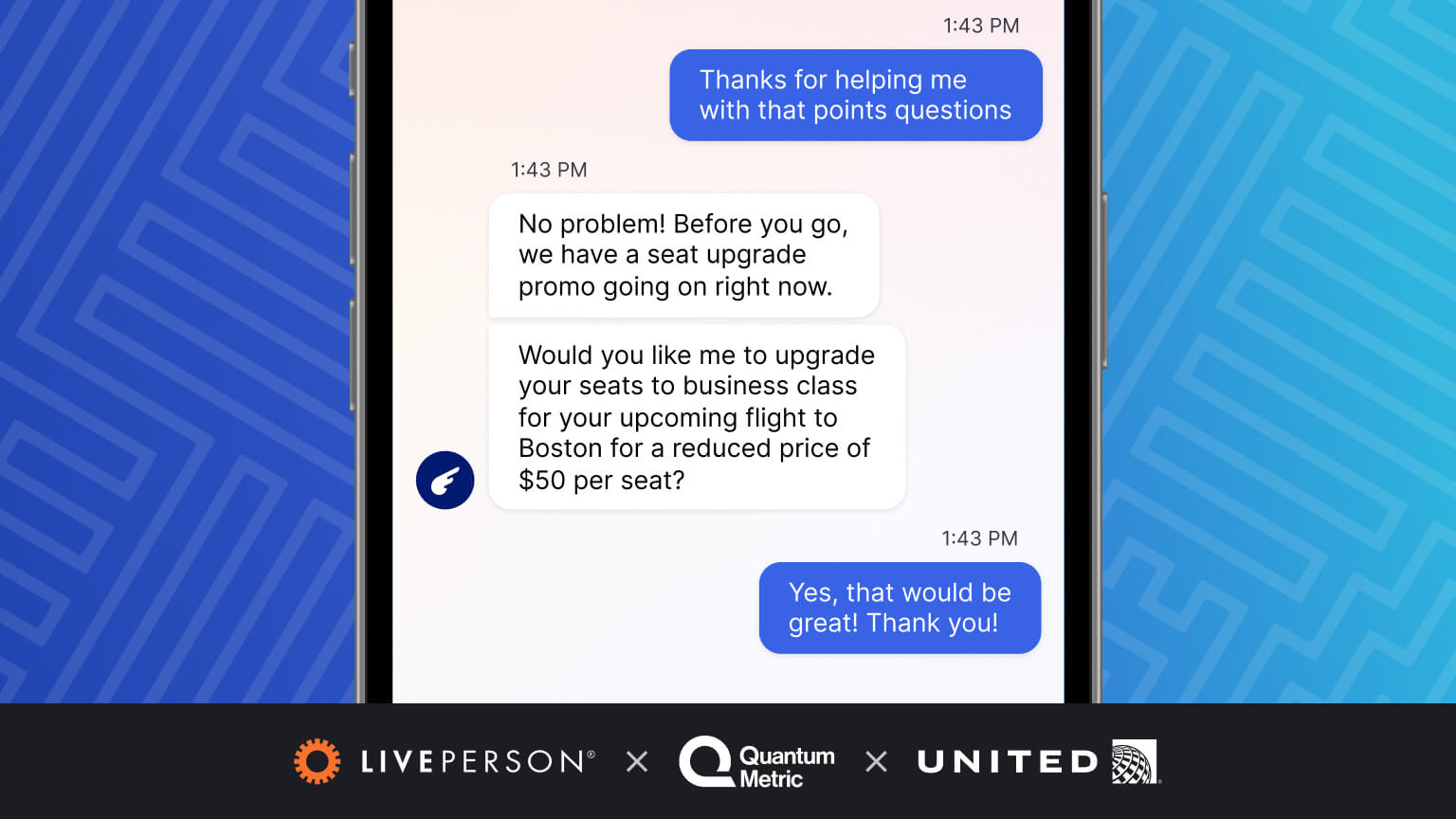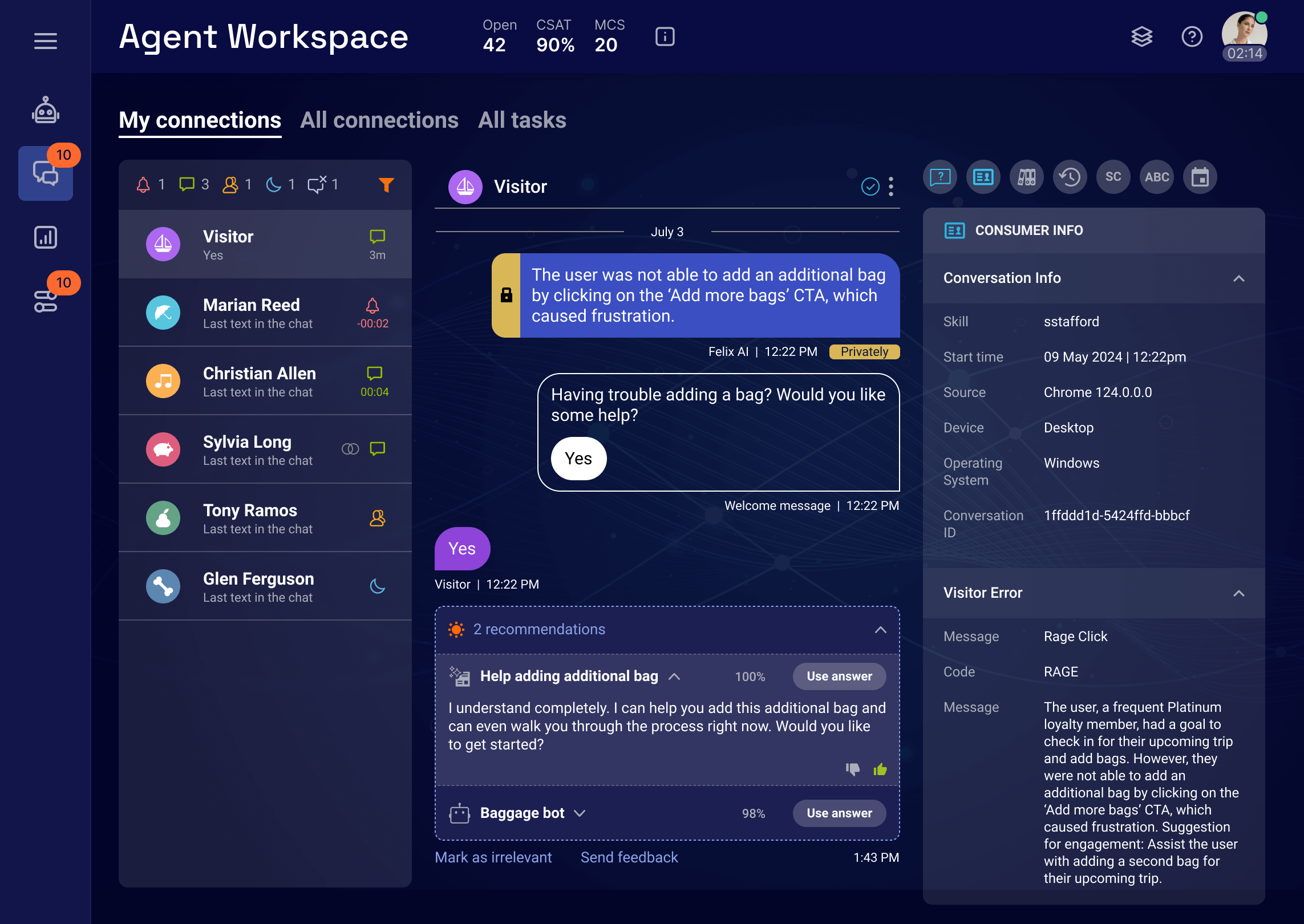article
Behind United Airlines’ new AI-powered contact center strategy
January 07, 2025 • 4 minutes

As the airline serving the most destinations worldwide, United Airlines manages an extraordinary volume of customer interactions daily throughout its contact and call center operations. Historically, the airline’s contact center strategy has been heavily phone-centric — so much so that even today, most error messages direct customers to a telephone number regardless of whether the issue requires escalation.
To better understand United’s evolution toward a more digital-first contact center strategy and their implementation of LivePerson’s solutions, we spoke with two industry leaders in a recent webinar: Angelica Zdanewicz, Senior Manager of Contact Center Channel Strategy at United, and Danielle Harvey, VP Travel and Hospitality at Quantum Metric.
Building a framework that improves both agent performance and customer experience
Working alongside Quantum Metric, a digital experience analytics platform, Zdanewicz and her team developed a sophisticated determination framework based on friction event insights — such as when customers encounter difficulties selecting airline seats online. This framework was a guide for helping contact center management decide how to engage customers and which ones to engage.
“After we connected the dots with Quantum, we started to marry those friction signals with actions in LivePerson,” explains Zdanewicz. “We built rules and criteria to guide agents’ interactions, so that each conversation is tailored to the customer and their unique situation.”
In developing this framework, the team prioritized call center best practices, ensuring their agents had the comprehensive tools and information for seamless customer interactions.
“First — and maybe uniquely — we talked to a lot of our contact center agents to pinpoint and understand their challenges and what they’re equipped to handle,” Zdanewicz notes. “What we don’t want to do is proactively route a customer to an agent who doesn’t have the tools, skill set, or know-how to recover that servicing opportunity.”
The resulting framework consisted of four key components to build their modern contact center strategy:
- Customer segment profile: Encompasses vital customer data, including name, demographics, upcoming flight information, and, for logged-in users, MileagePlus status details.
- Behavioral engagement: Analyzes customers’ historical interactions with United’s digital channels, including navigation patterns through self-service options or content pages, identifying potential areas of hesitation or frustration that could benefit from intervention.
- Current channel or footprint: Recognizes that engagement strategies may vary between united.com and the mobile app, requiring channel-specific approaches.
- Friction event detection: “This is probably the one I’m most interested in because it’s rooted in behavioral analytics and human behavior,” Zdanewicz shares. “This is where leveraging Quantum Metric and LivePerson has been invaluable in identifying those moments of struggle for customers.”
Checking a bag? A case study in AI-powered orchestration
Consider a customer — let’s call her Monica — selecting a flight on United’s website. She’s trying to add a piece of checked luggage, but the button isn’t responding. Like many frustrated users, she repeatedly clicks the button, triggering what Quantum Metric’s analytics system identifies as a “Rage Click.”

For Monica, this friction signal instantly communicates with the contact center AI software in real time, prompting LivePerson to initiate a precisely timed engagement designed to meet customers in their moments of need.
In this example, Monica’s struggle with the “Add More Bags” button generates a specific signal or event ID, enabling United to proactively display a “Trouble adding a bag?” message via the Routing AI Agent. This initiates a messaging flow available across multiple channels, including web messaging, iMessage, and SMS:
This valuable context seamlessly transfers to LivePerson’s agent workspace where, through a partnership with Quantum Metric’s FelixAI, contact or call center agents receive a comprehensive yet concise session summary.
Essentially, the system recognizes customer friction points and orchestrates personalized customer service conversations that resolve issues efficiently.
“In terms of the information and data being provided to our agents, it was awesome,” says Zdanewicz. “For our agents, it was just one extra click to get all of this information that previously wasn’t readily available because it was in a different portion of the agent desktop. It was received with resounding positive feedback.”
For United’s contact center strategy, the sky is the limit
The impact of United’s new AI-powered contact center strategy, implemented with LivePerson and Quantum Metric, became evident within just two months. Initial results revealed decreased conversation duration and handle times — alongside improved customer satisfaction scores.
And Zdanewicz and her team are just getting started: “Having that timely feedback and interception has considerably improved service recovery and the overall experience. We’re really excited to light up all four pillars of the framework with LivePerson’s new conversational AI and automation features.”


